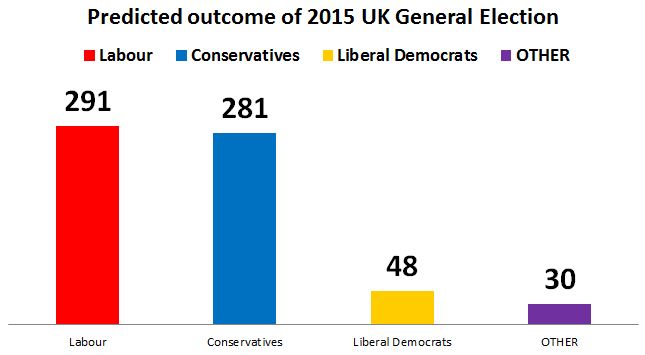World Politics
UK election 2015 Opinion Poll: Five more years for Clegg, as forecast tips Labour coalition with Lib-Dems, Overall seats forecast for UK election, UK election 2015 Opinion poll, UK election survey results
- Details
- Parent Category: World Politics
- Last Updated: Saturday, 07 February 2015 16:06
UK election 2015 Opinion Poll: Five more years for Clegg, as forecast tips Labour coalition with Lib-Dems
A tried-and-tested forecast model has predicted that after the general election in May the UK will be led by a coalition of the Labour and Liberal Democrat parties. The chart below shows the number of seats predicted for the different parties in the upcoming election, according to the “seats-votes” forecasting model. It shows Labour with 291 seats, the Conservatives with 281, the Liberal Democrats with 48, and other parties with 30 seats among them.
This model starts from the premise that winning a general election in Britain means gaining most seats in the House of Commons, not the most votes in a general election. There have been two occasions since the World War II when the party which won the most votes did not end up winning the most seats: once in 1951, and again in February, 1974. So, the model concentrates on seats rather than votes.
The forecasting model works by combining the number of seats won by parties in the previous election with vote intentions data from polls conducted six months prior to the election – in this case the data is from November 2014. Despite being a relatively simple model, it has a pretty good track record in predicting the elections of 2005 and 2010.
In 2005, the average prediction error for the Conservatives, Labour and Liberal Democrats was 11 seats – and, on that occasion, the model predicted that Labour would get 358 seats, when they actually won 356. It was slightly less accurate in 2010, with an average error of 18 seats for the three major parties. It predicted that the Conservatives would get 293 seats, when they actually won 307.
|
Predicted outcome of 2015 general election According to the seats-votes model |
|
|
Party |
No. of seats won |
|
Labour |
291 |
|
Conservatives |
281 |
|
Liberal Democrats |
48 |
|
OTHER |
30 |
Since the model uses data from every general elections since 1945, it can only work for parties that have been on the national scene since then. This means that we can’t forecast the seats won by minor parties like the SNP, UKIP and the Greens. To make it work, we have to guess how many seats these parties will win. This is clearly a big source of uncertainty.
Tackling uncertainty
In 2010 the SNP, Plaid Cymru, the Greens and the Northern Irish candidates won 28 seats between them. Interestingly enough, this number has been fairly stable for some time, averaging just under 30 seats in each election since 1997. So a starting point for the forecast is to assume that these parties are going to win the same number this year, leaving 620 seats to be shared between the three main parties.
The chart shows that Labour is forecast to be the largest party, just ten seats ahead of the Conservatives. But Labour is still expected to be quite some distance from a bare majority, which is 326 seats, and would need closer to 340 to sustain a workable majority in the House of Commons. The surprising thing is that the Lib Dems are forecast to win 48 seats rather than half or less of their present total of 57 seats, as some commentators have suggested.
This is surprising, given that the party is polling at about a third of its 2010 level of support, in terms of voting intentions. Yet the model shows that the party benefits from greater inertia provided by the seats it won last time, in comparison with the other two parties. Another way of putting it is that Lib Dem MPs are more likely to hold on to their seats – other things being equal – than the Tories or Labour.
The others
There is some support for this conclusion in the constituency polling provided by Lord Ashcroft. He commissioned polls in 20 Liberal Democrat-held marginal seats in September 2014. Of these seats, eight of them were retained by the party or tied, eight were won by the Conservatives and four by Labour, implying that the party was going to lose 12 of its seats. This would bring the Liberal Democrat total down to 45 seats in the new House of Commons, which is pretty close to the number forecast by the model.
The success of the SNP in the Labour heartlands in the referendum campaign might mean a big upsurge in SNP representation in the House of Commons. This would make our assumption that 30 seats will be won by minor parties unrealistic. But in an increasingly volatile electoral landscape, context really matters. In the independence referendum the SNP appeal to Labour voters was based on a highly positive, if rather romantic, view of Scotland’s future and the entire population was highly engaged in the debate.
In a UK general election, however, the SNP appeal will be based on the argument that they will wield any power they gain to promote Scotland’s interests at Westminster. This is a much less positive message, so the context will be very different from that of the referendum campaign. It is likely to mean that many Labour voters in Scotland will return to their party in May, particularly if Gordon Brown gets involved in the campaign.
What does this all mean? If the forecast is correct, it means another coalition government. But contrary to some commentary, this model predicts a two-party coalition, which should survive a five-year parliament.
src:theconversation.com



